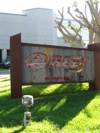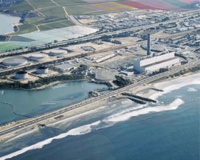by The Editors on July 13, 2007
by The Editors on July 12, 2007
 According to the North County Times, The Surfrider Foundation has filed suit asking the court to force the San Diego Regional Water Quality Control board to reconsider the discharge permit it renewed for Carlsbad’s Encina Power Station in August 2006.
According to the North County Times, The Surfrider Foundation has filed suit asking the court to force the San Diego Regional Water Quality Control board to reconsider the discharge permit it renewed for Carlsbad’s Encina Power Station in August 2006.
The permit allows the electrical station to suck in ocean water to cool its electricity-generating turbines, and then spit the water back out into the sea. A private company, Poseidon Resources, Inc., and the city of Carlsbad, are proposing to build a plant that would use a portion of the seawater the plant takes in, to filter out the salt and make it drinkable. . . Environmental groups say the “once-through-cooling” system harms the ocean, and that recent court decisions bar their use in the future.
This is the second time the Surfrider Foundation has tried stop the desalination plant in the permitting process.
[Link: North County Times]
by The Editors on July 12, 2007
 On Tuesday evening July 10, 2007, during the Carlsbad City Council meeting, after a long string of whereas, whereas, whereases, Mayor Bud Lewis made the official proclamation that July 14, 2007 is Lagoon Day in Carlsbad. Representatives from the various Lagoon Foundations (Agua Hedionad Lagoon Foundations, The Batiquitos Lagoon Foundation, and The Buena Vista Lagoon Foundation) attended the presentation and mentioned that all three Carlsbad lagoon foundations will be hosting lagoon appreciation functions this Saturday in celebration of the holiday.
On Tuesday evening July 10, 2007, during the Carlsbad City Council meeting, after a long string of whereas, whereas, whereases, Mayor Bud Lewis made the official proclamation that July 14, 2007 is Lagoon Day in Carlsbad. Representatives from the various Lagoon Foundations (Agua Hedionad Lagoon Foundations, The Batiquitos Lagoon Foundation, and The Buena Vista Lagoon Foundation) attended the presentation and mentioned that all three Carlsbad lagoon foundations will be hosting lagoon appreciation functions this Saturday in celebration of the holiday.
Check the websites listed above for more information on walks, hikes, birdwatching and much more nature loving fun. Or click here for the North County Times story.
by The Editors on July 9, 2007
 Carlsbad’s newest action sports neighbor, Reef, has finally jumped on the green marketing bandwagon, er, no, scratch that. . . they’ve decided they’d like to “leave a smaller footprint on the Earth” according to a story in the San Diego Business Journal.
Carlsbad’s newest action sports neighbor, Reef, has finally jumped on the green marketing bandwagon, er, no, scratch that. . . they’ve decided they’d like to “leave a smaller footprint on the Earth” according to a story in the San Diego Business Journal.
. . . the company plans to give back to the environment while introducing new eco-friendly products and emphasizing eco-friendly business practices. Marketing Vice President Kevin Flanagan said the business launched its three-tiered plan as part of its new campaign.
Go green. . .
[Link: San Diego Business Journal]
by The Editors on July 7, 2007
The California Coastal Commission has been on their game lately with Poseidon Resources, the company that wants to put a $300 million desalination plant in on the lagoon near the Encina Power Plant. For the fourth time this year they have rejected the plan saying it is sill “incomplete.”
Commission staff scientist Tom Luster rejected Poseidon’s latest application Tuesday, citing several topics on which he needed more information. Among those were alternative water-intake methods, environmental mitigation measures and the project’s financial feasibility.
While we like the idea of stealing less water from Northern California, it just seems like there must be better places for this than the Agua Hedionda Lagoon. (Click here for all of Carlsbadistan’s desalination plant coverage.)
[Link: San Diego Union-Tribune]
by The Editors on June 30, 2007
 Depending on how the permitting process goes, Carlsbad could be home to the world’s largest desalination plant. That all sounds fine, but what does it mean? Luckily for us Amy Westervelt has written a comprehensive story for the Sustainable Industries Journal in which she outlines the process, the politics, and the environmental issues associated with removing fresh water from ocean water.
Depending on how the permitting process goes, Carlsbad could be home to the world’s largest desalination plant. That all sounds fine, but what does it mean? Luckily for us Amy Westervelt has written a comprehensive story for the Sustainable Industries Journal in which she outlines the process, the politics, and the environmental issues associated with removing fresh water from ocean water.
The waste product created by the desalination process is a briny solution that is twice as salty as the ocean water it comes from. A desalination plant produces 50 million gallons of freshwater for every 100 million gallons of ocean water it takes in, according to Cooley, co-author of a 2006 report entitled “Desalination, with a Grain of Salt: A California Perspective.” Typically, the 50 million gallons of brine created by the desalination process are dumped back into the ocean.
That’s part of the reason that The Surfrider Foundation is fighting the Carlsbad plant. As General Electric’s project moves forward it’s important that we all have a better understanding of exactly what this means for Carlsbad and for the Coast.
[Link: Sustainable Industries]
by The Editors on June 28, 2007
Tom Troy, an Audubon board member, is leading a walk to help identify birds by sight and sound this Saturday (June 30) at 8:30 a.m. at the Buena Vista Lagoon Landing on Jefferson Street. And believe it or not, birding is fun, especially with good binocs.
[Link: BV Audubon]
by The Editors on June 22, 2007
The new Carlsbad Country Day school (infants through kindergarten) has installed 154 solar panels from Clean Power Systems that will save the school an average of $770 per month in electricity bills or about “$400,00 over a 30 year period.”
We’re very excited about our new school and its impact on our community not only as an educational institution that serves the children’s learning and development in their early years but as a shining example of how we can bring to bear the newest renewable technology to conserve energy and make our planet a better place to live for future generations,” says Darrell Reed, owner and chief executive officer of Carlsbad Country Day School.
We’re sure the school will pass on these energy savings to the parents in tuition discounts. Right? Because that would be great.
[Link: Alternative Energy Retailer magazine]
by The Editors on June 20, 2007
 The Surfrider Foundation, San Diego Coastkeeper, and other groups recently lost a challenge over a discharge permit for the Carlsbad desalination plant, however, KPBS reporter Ed Joyce says that drinkable sea water in Carlsbad is still a long way off.
The Surfrider Foundation, San Diego Coastkeeper, and other groups recently lost a challenge over a discharge permit for the Carlsbad desalination plant, however, KPBS reporter Ed Joyce says that drinkable sea water in Carlsbad is still a long way off.
The $300 million Carlsbad desalination plant would be the largest in the Western Hemisphere. Poseidon Resources says its plant would convert seawater to 50 million gallons of drinking water a day. The plant uses a reverse osmosis process to remove the salt. The saltier byproduct is then sent back out to the ocean. Environmental groups say the process of sucking in and releasing seawater harms marine life.
We don’t know if we’re $300 million thirsty. Are you?
[Link: KPBS]
by The Editors on June 16, 2007
We’ve been seeing a few too many sea lions lately. The other day while surfing we saw a destressed looking sea lion floating vertically just outside the lineup with only his nose out of the water. The next day a dead one washed up on the beach. Then yesterday morning, June 15, a baby Sea Lion pup washed up on the beach at Cherry Street. It was alive and doing well. The life guards called SeaWorld and:
The SeaWorld team arrived about 10 a.m. and decided to take the animal to diagnose it, said lifeguard Matthew Clark. The team couldn’t diagnose it in the field and they didn’t want to leave it there because it was so young, he said.
Wonder what will happen to this pup? Hopefully, it won’t show any aptitude for entertaining huge throngs of toursits. If it does, it will be a long, hard road to freedom.
[Link: North County Times]




